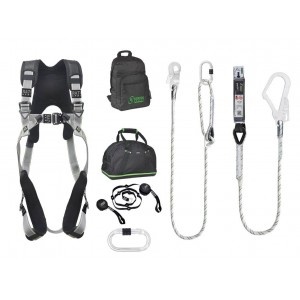When operating within the lifting gear industry, it is commonplace that workers will need to be operating at height. Lifting equipment, which often finds itself in industries such as construction, engineering or shipbuilding, can involve use on extremely tall structures.
But, workers may also be operating at much smaller heights too, but enough of a distance to cause harm should something go wrong. For that reason, it’s crucial to have height rescue plans in place. You can follow our full guide below.
Working at height rescue plans
Working at height might not be as high as you think!
What does the law say about working at height?
There are very clear laws in place for anyone that will be operating at height. Previously, it was required that if operating at a distance greater than 2 metres, the right PPE (personal protective equipment) was required. The law has since been changed, and this requirement is needed ”where a person could fall a distance liable to cause personal injury.”
While this could be a little more open to interpretation, this is defined as:
- If you will be working above the ground/floor level
- If it is possible that you could fall from an edge, through a fragile surface, or through an opening
- If you could fall from the ground level through an opening or hole in the ground
In short, it is best to take necessary precautions and over-protect yourself rather than risk any harm coming to you or your workers.
Developing effective height rescue plans
There are several considerations that you must make if you plan to be working at height. One is to have the right height safety equipment, which we have referred to in the section below. Other things you’ll need to think about are:
- Ensuring that all of your staff are fully trained in the equipment being used
- All equipment and gear is fully inspected before use
And, it’s important that you don’t only rely on the emergency services if something should go wrong. Instead, you must have a robust height rescue plan in place beforehand. This is a plan that you can quickly enact on should something go wrong when working at height.
This plan should address factors such as:
- The anchor points for equipment being used
- The safety of those that will be conducting any rescuing
- How suitable the equipment is
- What rescue equipment is likely to be needed
- How an individual will be attached to the rescue equipment
- How the equipment will be used to move an individual
- Any other needs, such as medical, of the individual involved in the rescue process
Part of putting your plan together will involve the conducting of a thorough risk assessment before any operation begins. You’ll need to examine any hazards that may be posed by the task and evaluate these risks.
Personal protective equipment
Think about personal protective equipment (PPE) for your workers
Falls from height are one of the most common causes of fatality in the UK each year, with them accounting for 28% of all deaths over the last five years. For this reason, it is absolutely crucial that you are working to a height rescue plan should anything go wrong. Height safety harnesses together with a safety lanyard are basic equipment commonly sold in kit form and used for every day tasks. Fall arrestors are a great piece of kit for actually catching you should you fall. Considering the equipment you will use for safety and rescue alongside the actual task will help plan your risk assessment and recovery plans.
How we can help
We can help by ensuring you are provided with robust, strong and well-manufactured equipment to help protect you and your workers when operating at height. We have a huge range of height safety equipment that can ensure all operations are carried out safely and smoothly.
And, if you would like assistance or guidance when it comes to height rescue plans, we would be more than happy to share our knowledge on this too. Please get in touch with us.
Posted On: December 20, 2017

